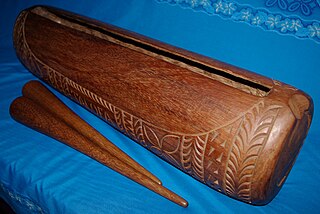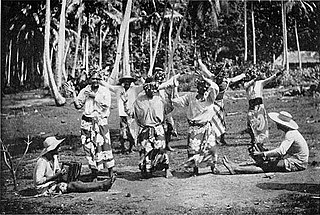Related Research Articles

Polyphony is a type of musical texture consisting of two or more simultaneous lines of independent melody, as opposed to a musical texture with just one voice (monophony) or a texture with one dominant melodic voice accompanied by chords (homophony).
The music of Polynesia is a diverse set of musical traditions from islands within a large area of the central and southern Pacific Ocean, approximately a triangle with New Zealand, Hawaii and Easter Island forming its corners. Traditional Polynesian music is largely an inseparable part of a broader performance art form, incorporating dance and recital of oral traditions; most literature considers Polynesian music and dance together. Polynesian music expanded with colonial European contact and incorporated instruments and styles introduced through a process of acculturation that continues to the present day. Although the European tradition of hymn-singing brought by Christian missionaries was probably the most important influence, others are evident; Hawaii's influential kī hōʻalu music incorporated the Spanish guitar introduced in the late 19th century, and later introduced the steel guitar to country music. Hip hop and R&B influences have created a contemporary Urban Pasifika music genre with a strong Polynesian identity and supported by the annual Pacific Music Awards in New Zealand.

Music of Tonga refers to music derived from the island Tonga in the islands of Polynesia. Music of Tonga today generally falls under the category of traditional music that has withstood the test of time, or into one of the two opposing genres of religious and secular music. Tongan music can be either very emotional and somewhat modern with instrumental makeup including modern brass instruments, or conversely can be more traditional and consist of only drums and voices. In this way, Tongan music is very diverse despite the fact that it is contained to a fairly small island, which means that the different cultures and styles co-exist on the small land mass together without blending.
The music of French Polynesia came to the forefront of the world music scene in 1992, with the release of The Tahitian Choir's recordings of unaccompanied vocal Christian music called himene tārava, recorded by French musicologist Pascal Nabet-Meyer. This form of singing is common in French Polynesia and the Cook Islands, and is distinguished by a unique drop in pitch at the end of the phrases, which is a characteristic formed by several different voices; it is also accompanied by steady grunting of staccato, nonsensical syllables.

The highly diverse and distinctive music of Madagascar has been shaped by the musical traditions of Southeast Asia, Africa, Oceania, Arabia, England, France and the United States over time as indigenous people, immigrants, and colonists have made the island their home. Traditional instruments reflect these widespread origins: the mandoliny and kabosy owe their existence to the introduction of the guitar by early Arab or European seafarers, the ubiquitous djembe originated in mainland Africa and the valiha—the bamboo tube zither considered the national instrument of Madagascar—directly evolved from an earlier form of zither carried with the first Austronesian settlers on their outrigger canoes.

A rhythm section is a group of musicians within a music ensemble or band that provides the underlying rhythm, harmony and pulse of the accompaniment, providing a rhythmic and harmonic reference and "beat" for the rest of the band. The rhythm section is often contrasted with the roles of other musicians in the band, such as the lead guitarist or lead vocals whose primary job is to carry the melody.

Prior to the arrival of Europeans, the music of Tahiti was dominated by festivals called heiva. Dancing was a vital part of Tahitian life then, and dances were used to celebrate, pray and mark almost every occasion of life. Examples include the men's ʻōteʻa dance and the couple's 'upaʻupa.
Fiji is an island nation in the Pacific Ocean. Though geographically Melanesian, the music of Fiji is more Polynesian in character. Nevertheless, Fijian folk styles are distinct in their fusion of Polynesian and Melanesian traditions. Folk music is dominated by vocal church music, as well as dances characterized by rich and dull harmony and complex percussion made from slit drums or natural materials, such as drums.

The Music of Samoa is a complex mix of cultures and traditions, with pre- and post-European contact histories. Since American colonization, popular traditions such as rap and hip hop have been integrated into Samoan music.

The traditional music of Tuvalu consists of dances, including fatele, fakanau and fakaseasea. The influence of the Samoan missionaries sent to Tuvalu by the London Missionary Society from the 1860s resulted in the suppression of songs about the traditional religions or magic and many songs were lost. As the influence of the missionaries diminished in the 20th century the traditional dances were revived and the siva dance tradition from Samoa also became popular.

Samoans or Samoan people are the indigenous Polynesian people of the Samoan Islands, an archipelago in Polynesia, who speak the Samoan language. The group's home islands are politically and geographically divided between the Independent State of Samoa and American Samoa, an unincorporated territory of the United States of America. Though divided by national border, the culture and language are the same.
Himene tarava is a style of traditional Tahitian music.

The Pātē is a Samoan percussion instrument of Tahitian origin, named after the Samoan word for "beat" or "clap" "pulse". It is one of many Samoan log drum variants and is of the slit drum family, and therefore is also of the idiophone percussion family. It is made from a hollowed-out log, usually of Miro wood and produces a distinctive and loud sound. Different sizes of log drums offer different pitches and volumes, as well as striking the log drum in the middle or near the ends.
An imene tuki is a traditional hymn of the Cook Islands. It is accompanied singing noted for a drop and raise in pitch at the end of phrases, and rhythmic nonsensical syllables, comparable to Scat singing. Similar syllables and improvisations are found in Tahitian Himene tarava.
Imene reo metua: a Cook Islands / Rarotongan term; : they are formal traditional songs with tune and harmony, which are distinguished from the imene tuki style of the Cook Islands which are less formal, often grunted verses with nonsense syllables included for rhythmic effect. Most were brought to the islands by missionaries in the nineteenth century.
Oe Himene are formal choral Tahitian songs, often of religious nature. Himene is a Tahitian term derived from the English word hymn.

Vocal harmony is a style of vocal music in which a consonant note or notes are simultaneously sung as a main melody in a predominantly homophonic texture. Vocal harmonies are used in many subgenres of European art music, including Classical choral music and opera and in the popular styles from many Western cultures ranging from folk songs and musical theater pieces to rock ballads. In the simplest style of vocal harmony, the main vocal melody is supported by a single backup vocal line, either at a pitch which is above or below the main vocal line, often in thirds or sixths which fit in with the chord progression used in the song. In more complex vocal harmony arrangements, different backup singers may sing two or even three other notes at the same time as each of the main melody notes, mostly with a consonant, pleasing-sounding thirds, sixths, and fifths.

Tahitian drumming is a style of drumming native to Tahiti and French Polynesia. Tahitian drumming and dance have become symbols of Polynesian heiva to the western world. Heiva is the Tahitian term for entertainment. This authentic performance symbolizes the past and present state of social hierarchies within the community and the island. There has been a significant amount of change to Tahitian drum dancing within the past fifty years. These changes have come from many different aspects of Polynesian society. However, many of them stem from the broader outreach of this tradition to the rest of the world. This music has served as inspiration for many other styles across the globe, especially in other areas of the Pacific.

The culture of the Cook Islands reflects the traditions of its fifteen islands as a Polynesian island country, spread over 1,800,000 square kilometres (690,000 sq mi) in the South Pacific Ocean. It is in free association with New Zealand. Its traditions are based on the influences of those who settled the islands over several centuries. Polynesian people from Tahiti settled in the Cook Islands in the 6th century. The Portuguese captain, Pedro Fernandes de Queirós, made the first recorded European landing in the islands in the early 17th century, and well over a hundred years later, in the 18th century, the British navigator, Captain James Cook arrived, giving the islands their current name. Missionaries developed a written language, bringing schools and Christianity to the Cook Islands in the early 19th century. Cook Islands Māori, also known as Māori Kūki 'Āirani or Rarotongan, is the country's official language.

The fatele or faatele is a traditional dance song of Tuvalu. Dancing songs are the most common type of traditional Tuvaluan song, with other traditional dance styles including fakanau and fakaseasea.
References
- 1 2 Cook Islands
- ↑ Linkels
- Linkels, Ad. "The Real Music of Paradise". 2000. In Broughton, Simon and Ellingham, Mark with McConnachie, James and Duane, Orla (Ed.), World Music, Vol. 2: Latin & North America, Caribbean, India, Asia and Pacific, pp 218–229. Rough Guides Ltd, Penguin Books. ISBN 1-85828-636-0
- "Art and Culture". Cook Islands. 2006. Retrieved April 10, 2006.